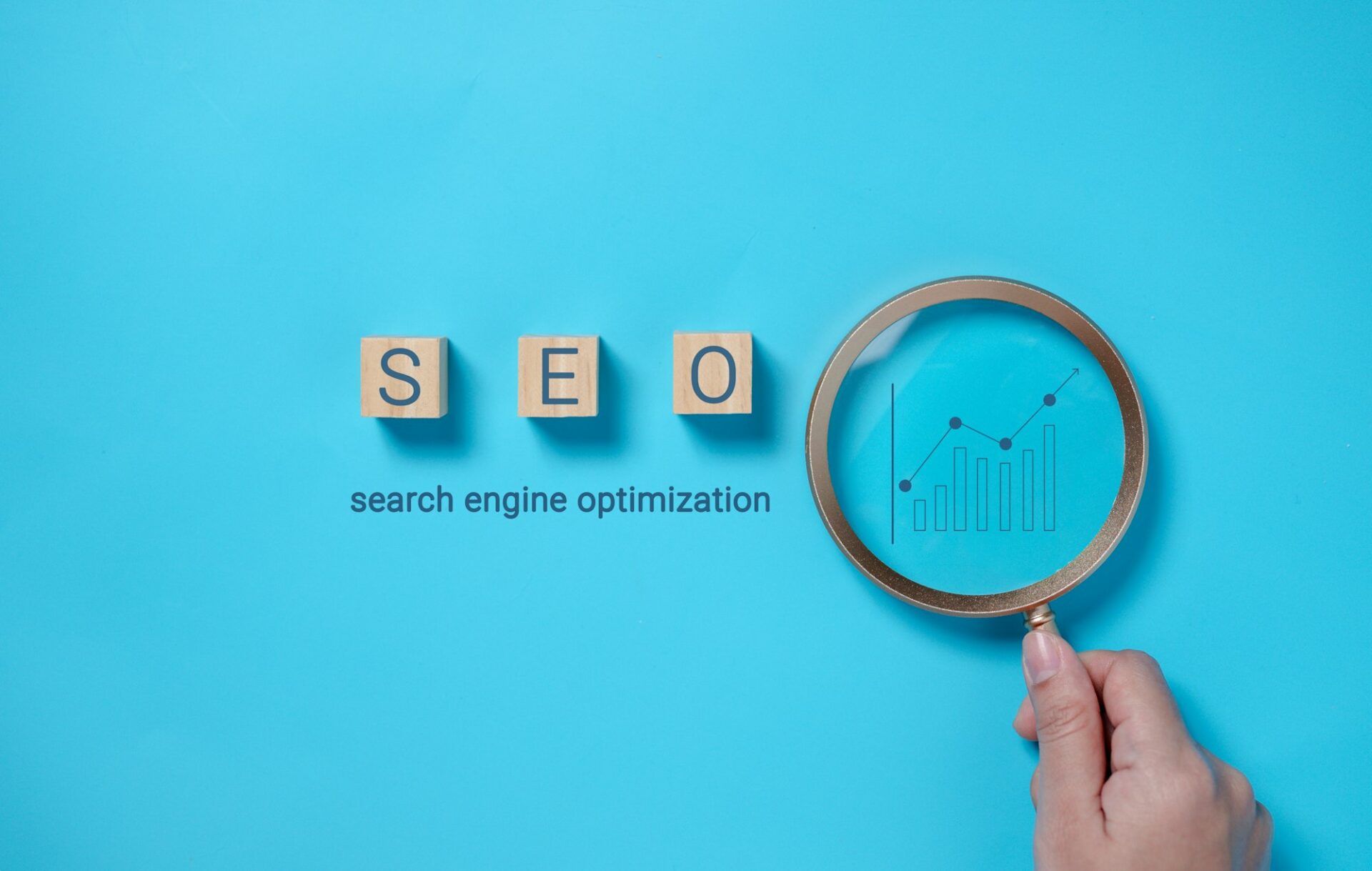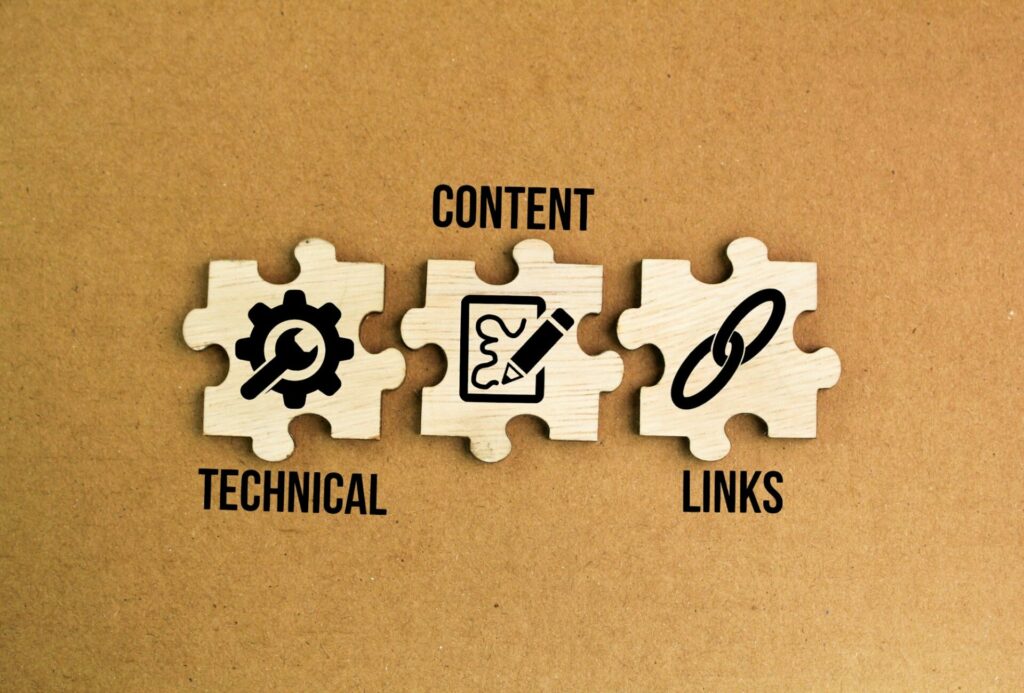
OnPage optimization: Everything for a better ranking!
In today’s digital world, OnPage Optimization is an indispensable tool for improving the visibility of your website in search engines. While many rely on off-page
SEO, the abbreviation for search engine optimization, is a well-known term today and is becoming increasingly relevant. Let’s say you want to buy a washing machine. Like most people, you will inform yourself online in advance and then, of course, search for washing machines on the Internet.
If you have a company and sell washing machines, then it is of course relevant for sales to be in the top 10 for keyword “buy washing machine”. In today’s digital world, many people and companies create an online presence, usually on a search engine such as Google or Bing. A well-optimized online presence can attract five times as many customers – it’s amazing how many people you can reach with it.
You also want your online presence (website, blog, e-shop) to appear on the first pages of search results and enjoy the benefits. The ranking is determined by the search engine, but you have control over how well you optimize your website for this search engine. This is where SEO comes into play.
With the help of SEO, you can optimize your website according to the latest search engine algorithms and thus receive preferential treatment. After all, most people click on the first 5 links that appear on the first page of a Google search
If you are interested in SEO consulting, please get in touch with us. We will advise you at your request. Our goal is for your website to be found on Google for your relevant keywords as soon as possible. We look forward to hearing from you!

SEO, the abbreviation for Search Engine Optimization, is the process of improving the visibility of a website in the organic (non-paid) search engine results.
The aim of SEO is to increase the position of a website in the search results for relevant search terms or keywords. The higher a website appears in the search results, the more likely it is to be clicked on by users. And this has been proven by Google studies!
SEO encompasses a variety of techniques and strategies that aim to optimize both the technical structure and the content of a website. It is therefore about optimizing your website and its content so that you rank on the first page of Google for the relevant search terms in your industry (keywords).
This is not about placing advertisements and ranking at the top for a specific keyword. No, it’s about being displayed on the first page naturally and for reasons of quality.</p
SEO plays an important role in digital marketing because it offers several advantages:
Most internet users start their online activities with a search query. When your website appears at the top of search results, it increases visibility and encourages them to visit your website.
Users tend to trust websites that appear on the first pages of search results. (This in turn leads to a better ranking)
In contrast to paid advertising, where you have to pay for every click, SEO generates organic traffic.
This means that users find and visit your website without you having to pay for the click. Once well optimized, a website can continuously attract traffic without incurring ongoing costs.
Websites that rank highly in organic search results are often perceived as more trustworthy and credible.
Search engines like Google rate pages according to their relevance and quality. A high position in the search results signals to users that your website is rated as high quality and relevant by the search engine.
Many SEO practices also contribute to improving the user experience. A well-structured website, fast loading times and high-quality content ensure that visitors stay on your site longer and are more likely to become customers.
User experience (UX) refers to how users perceive a website and how easy and pleasant it is for them to find the desired information or perform actions.
In many industries, competition online is very high. An effective SEO strategy can help you stand out from your competitors and attract potential customers to your website.
While implementing and maintaining SEO can take lots and lots and lots of time and resources, the long-term costs are often lower compared to paid advertising campaigns.
SEO offers an excellent cost-benefit ratio, especially when you consider long-term, sustainable traffic.
Is SEO useful? SEO is useful and important! SEO (search engine optimization) consists of measures that are necessary to rank on Google in the first place.
These measures help with the visibility and web presence of your website! The presence, web presence and visibility of a website are important for searchers. Many searchers click on the first result on Google! The reasons why SEO is important: SEO measures contribute to an improvement in search engine rankings (Google, Bing, Yahoo …).
This in turn leads to a professional online presence and a highly professional first impression.
Falls Du Interesse an einer SEO-Beratung hast, dann melde Dich bei uns. Wir beraten Dich auf Deinen Wunsch. Unser Ziel ist es, dass Deine Website möglichst bald bei Google für Deine relevanten Keywords gefunden wird. Wir freuen uns auf Deine Anfrage!
The history of SEO began in the 1990s, when the first search engines such as Archie and Yahoo emerged. With the advent of Google in 1998, SEO gained prominence as companies realized the importance of being visible in search results. Over the years, SEO has evolved to meet the ever-changing algorithms of search engines.
The history of search engines began in the early 1990s, when the internet was still in its infancy. One of the first search engines was “Archie“, developed by Alan Emtage in 1990, which helped to search FTP archives.
Soon after, other search engines followed, such as “Veronica” and “Jughead“, which offered similar functions for Gopher files.
In 1998, Larry Page and Sergey Brin revolutionized the world of search engines with the creation of Google . Google’s PageRank algorithm ranked websites based on the number and quality of links pointing to them.
This new method provided more relevant search results and quickly made Google the users’ preferred search engine.
In the early 2000s, SEO practices focused heavily on so-called keyword stuffing, where websites were filled with as many keywords as possible to achieve better rankings. Meta tags, especially the meta keywords tag, played a major role, as search engines took this information heavily into account.
These simple methods quickly became popular, but were also abused, which led to a decrease in the quality of results.
In response to manipulative SEO tactics, search engines such as Google began to regularly update their algorithms. The focus increasingly shifted to the quality and relevance of content as well as the user experience.
Between 2011 and 2012, Google released two major updates: Panda and Penguin. The Panda update (2011) aimed to penalize websites with low-quality or duplicate content, while the Penguin update (2012) targeted websites that used manipulative link-building tactics.
These updates forced SEOs to rethink their strategies and focus on high-quality content and natural link profiles.
In recent years, SEO has evolved to take into account the increasing use of mobile devices and the role of artificial intelligence (AI).
Google’s mobile-first indexing, introduced in 2018, prioritizes the mobile version of websites in search results. In addition, Google uses AI technologies such as RankBrain to tailor search results even more precisely to the needs of users.
With the spread of voice assistants such as Siri, Alexa and Google Assistant, voice search is becoming increasingly important. This leads to new challenges and opportunities for SEO, as search queries have to be processed and optimized in natural language.
If you are interested in SEO consulting, please get in touch with us. We will advise you at your request. Our goal is for your website to be found on Google for your relevant keywords as soon as possible. We look forward to hearing from you!

Search engines search the internet with the help of so-called crawlers or bots that analyze and index websites. This information is stored in a huge database. When a user enters a search query, the search engine searches this database and returns the most relevant results based on complex algorithms. These algorithms take into account various factors such as keywords, page structure, links and user behavior to determine the order of search results.
Search engine algorithms are complex systems that determine which websites are displayed for a particular search query. They take into account numerous factors such as relevance, quality of content, user experience and many others to determine the order of search results.
Google, for example, uses over 200 ranking factors in its algorithm.
Search engines use “crawlers” or “bots” that crawl the internet and find websites. These bots follow links from page to page and collect information about the content of each page.
The information collected is stored in a huge database index. This index contains all the relevant data about the websites so that they can be retrieved quickly at a later date.
When a user enters a search query, the search engine searches the index and returns the most relevant results. The order in which the pages are displayed is based on the search engine’s algorithms.
Of course, the exact algorithm that Google uses to rank a website in a search engine is a well-kept secret. However, there are around 200 ranking factors that are known to every SEO agency that can influence reach in search engines.
Broadly speaking, these ranking factors can be divided into two sub-areas of SEO that you can work on to increase the visibility of your website in search engines.
On-page SEO refers to all measures that are carried out directly on the website to improve visibility in search engines. This includes the optimization of content, meta tags, URLs, header tags and images.
Offpage optimization includes all activities outside of your own website that help to improve your ranking. The main focus here is on building backlinks, i.e. links from other websites that refer to your own site.
Technical SEO focuses on improving the technical aspects of a website to ensure that search engines can crawl and index it effectively.
This includes measures such as improving website speed, mobile optimization, XML sitemaps and fixing crawling errors.
Local SEO is designed to increase the visibility of a website in local search results. This is particularly important for businesses that want to attract customers in their immediate area.
Measures include optimizing the Google My Business profile, local directory listings and collecting customer reviews.
Here we go into these topics in more depth.
What is on-page SEO? OnPage SEO means optimizing the content, technology and structure of your website. The most important building blocks of on-page SEO include: domain name, page title, keywords, meta description (metadata), meta tags, header tags (headings), encrypted HTTPS and much more.
These elements of on-page SEO contribute to the optimization and visibility of the website and lead to a better ranking on search engines.

OnPage optimization is about concrete improvements to the technology of the website that can lead to a better ranking. A very important part of this is the page load speed of the website. Today, over 60% of search queries are made from mobile devices such as smartphones and tablets.
This means that websites that load quickly and are easy to use on mobile devices are naturally at the top of the list. Of course, data protection also plays a role. Websites that respect data protection are preferred in Google searches.
Finally, the content of the website must be so appealing to visitors that they like to stay on it for a long time. To this end, it makes sense to hire an SEO agency that will make your website appealing and user-friendly.
Keyword research is the first step in any SEO strategy. It helps you to identify the terms that your target group is searching for. These keywords should be strategically placed in the content, headings and meta tags of your website to increase relevance and rank better in search results.
High-quality, relevant content is crucial for SEO success. Content should not only be well-written and informative, but also address the needs and questions of your target audience. Regular updates and additions to content help to keep your website relevant and up-to-date.
Meta tags play an important role in on-page optimization. The title tag should contain the main keyword and give a clear indication of the content of the page. Meta descriptions provide a brief summary of the page content and should also contain relevant keywords to increase the click-through rate (CTR).
A clear and comprehensible URL structure helps both users and search engines to better understand the content of a page. URLs should be short, concise and keyword-relevant. Avoid long and cryptic URLs, as these can be confusing.
Header tags structure the content of a page and make it easier for readers to understand. The H1 heading should contain the main keyword and clearly define the main topic of the page.
Subordinate header tags (H2, H3, etc.) help to divide the text into logical sections and improve readability and SEO.
Images should be optimized to improve the loading time of the website and increase search engine friendliness.
The alt text describes the content of the image and helps search engines to understand the image. Relevant file names and compressed image sizes also contribute to optimization.
Internal links improve navigation on your website and help search engines to crawl and index all pages. They should point to relevant content within the website and help users find more information.
If you are interested in SEO consulting, please get in touch with us. We will advise you at your request. Our goal is for your website to be found on Google for your relevant keywords as soon as possible. We look forward to hearing from you!
The second part of SEO optimization is all about increasing the external visibility of the website. One of the central tasks here is to increase the links from other websites or social networks to your own company website.
On the one hand, you can build up a large community on YouTube, TikTok, Instagram or Facebook, for example, where contributions to the website can be shared and discussed.
On the other hand, you can also use a specific backlink strategy, such as writing guest articles, to increase the links from other websites to your own website.
Of course, the more high-quality backlinks a website has and the more it is discussed on social networks, the better it will rank in search engines.
Backlinks are links from other websites that refer to your website. They are an important ranking factor as they serve as a trust signal for search engines. High-quality backlinks from trustworthy sites can improve your SEO.
To acquire high-quality backlinks, you should create high-quality, shareable content that encourages others to link to it. Guest posting on other blogs, sharing content on social media and collaborating with influencers are other effective strategies.
Social signals such as likes, shares and comments on social media platforms can also influence SEO rankings. They show search engines that the content is relevant and popular, which can increase visibility.
Guest posts on other blogs offer the opportunity to acquire high-quality backlinks and increase the reach of your content.
Die Zusammenarbeit mit Influencern kann helfen, die Sichtbarkeit Deiner Website zu erhöhen und Backlinks zu erhalten. Influencer können Deine Inhalte teilen und so eine größere Zielgruppe erreichen.
Technical SEO involves optimizing the technical aspects of a website to improve its visibility and user-friendliness in search engines. This includes measures such as improving loading times, mobile optimization, setting up a clean URL structure, using SSL certificates and optimizing the crawlability and indexability of the website. The aim is to make it easier for search engines to understand and evaluate website content.
The loading speed of a website is an important factor for the user experience and SEO ranking. Slow websites lead to higher bounce rates and lower rankings. Optimize images, use caching and minimize the number of HTTP requests to improve speed.
More and more users are accessing the internet via mobile devices. A mobile-friendly website is therefore crucial for good SEO rankings. Responsive design and fast loading times on mobile devices are particularly important here.
An XML sitemap helps search engines to find and index all pages of your website. It should be updated regularly to ensure that all new content is taken into account.
The Robots.txt file gives search engines instructions on which pages they should crawl and index. It helps to control the crawl process and ensure that important pages are captured.
Structured data helps search engines to better understand the content of your website. They can be used to generate rich snippets in the search results, which can increase the click-through rate.
HTTPS encrypts the data transfer between the browser and the website and improves security. Search engines prefer secure websites and rank them higher.
Crawling errors can lead to important pages not being indexed. It is important to check and correct these errors regularly to ensure that all content is captured correctly.
Local SEO refers to the optimization of a website in order to be more visible in local search results. This includes measures such as creating and maintaining a Google My Business profile, integrating local keywords, optimizing NAP data (name, address, phone number) and collecting customer reviews. The aim is to make businesses visible to users searching for local services or products.
Local SEO is particularly important for businesses that want to attract customers in their immediate area. By optimizing for local search queries, businesses can increase their visibility in local search results.
This is especially beneficial for small and medium-sized businesses that rely on local clientele. A well-executed local SEO can significantly increase online leads.
An optimized Google My Business profile is important for success in local SEO. It should contain complete and accurate information about the business, including address, phone number, opening hours and a description of services.
Regular updates and uploading photos can further increase the attractiveness of your profile. Customer reviews and responses should also be actively maintained.
Local citations are mentions of the business name, address and phone number on other websites, even without a direct backlink. Listings in local directories and business directories such as Yelp, Yellow Pages and other specific directories help increase visibility in local search results.
It is important that the information is consistent and up-to-date to gain trust from search engines and users.
Positive reviews and high ratings play a key role in local SEO. They not only influence the decision of potential customers, but also the ranking in search results. Businesses should actively ask customers for reviews and respond to all reviews, both positive and negative.
This shows commitment and improves the reputation of your business.
Localized content refers to content that is created specifically for the local target group. This can be blog posts about local events, news or activities.
Such content not only helps to increase the relevance of the website for local search queries, but also provides added value for the local community and improves user retention.
If you are interested in SEO consulting, please get in touch with us. We will advise you at your request. Our goal is for your website to be found on Google for your relevant keywords as soon as possible. We look forward to hearing from you!

Content and SEO (search engine optimization) are closely linked. High-quality, relevant content is crucial to perform well in search engine rankings. Good content not only attracts visitors, but also ensures that they stay longer on the website and return.
Important SEO aspects such as the use of keywords, meta descriptions and the optimization of images must be taken into account in order to improve visibility. Overall, the goal is to provide valuable information to both users and search engines to maximize rankings in search results.
High-quality content is at the heart of any successful SEO strategy. It should be informative, well-researched and tailored to the needs of the target audience.
Search engines prefer sites that offer relevant and useful information. Regular updates and additions to content keep the website fresh and relevant.
An effective content marketing strategy involves the planning, creation and distribution of content that appeals to the target audience. This includes blog posts, articles, infographics, e-books and social media posts.
The aim is to attract the attention of users through valuable content and encourage them to interact. This not only promotes visibility in search engines, but also strengthens customer loyalty.
A blog is a great way to regularly create new content and improve SEO rankings. Each blog post should contain relevant keywords and address the interests and questions of the target audience.
Reach and visibility can be further increased through internal linking and sharing posts on social media.
Videos are a powerful tool to increase the time spent on the website and improve the user experience. Optimized videos should contain relevant titles, descriptions and tags.
A positive user experience is crucial for good SEO rankings. A well-structured website, fast loading times and an appealing design help to ensure that visitors stay on the site longer and are more likely to become customers.
Search engines such as Google also evaluate user-friendliness, so navigation, interactivity and general user satisfaction should always be the focus.
It’s important to first understand what you’re writing content for. First and foremost, you are writing posts for real people who want to read them. However, in order for your posts to be found on Google, you have to adhere to certain SEO guidelines.
Thus, good SEO text is good for both people and search engines.
First of all, an SEO text can only rank well if it covers topics and search terms that are frequently searched for. To do this, a keyword analysis is usually carried out to see how often certain search terms are searched for in your industry.
For a company that sells washing machines, for example, it would be important to write an SEO text on the topic of “Buying washing machines – what to look out for!”. Here you can already see from the title what is important, you build in the keyword “Buy washing machines” for the search engines.
The second part – “You have to pay attention to this!” is built in for people, because you really want to offer added value with the text.
A good SEO text is sensibly organized and structured, with headings that captivate the reader. For example, you can enter “buy washing machines” into Google.
You will then see other suggestions at the bottom that people are looking for. For example, you can include a headline on washing machine test winners if you have something interesting to report.
The structure of an SEO text should be logical and profitable for the reader and really contain relevant elements that provide advice.
There was a time when you could get to number 1 on Google with 300-word SEO texts. However, those days are long gone. Of course, you shouldn’t artificially lengthen an article.
However, anyone who has ever written a really good article with relevant information will quickly realize that this is also difficult to do with less than 600 words.
Longer articles are also generally found better in the long tail, i.e. with a large number of small search queries and various word combinations.
If you are writing an article about the topic “buy washing machines” or “what is SEO”, then this keyword should also appear in the title, in the meta description and in the text.
However, a text that only contains the keyword “buy washing machines” would not be good, as you have a keyword density of 100% here. In our experience, texts in which the keyword density of the main keyword is between 2 and 4 % are optimal.
Finally, it is always good if you refer to relevant third-party articles in the text, for example wikipedia.de, and link to other relevant articles in the text, for example on the topic of “washing machine accessories”.
According to our knowledge, a good SEO text should contain between one to three external links to another page and two to seven internal links to your own website.
Many copywriters try to cram in the keyword again and again, whereby the reading flow can suffer extremely as a result.
You should also pay attention to good expression and appropriate spelling. There are various tools on the Internet such as the LanguageTool, which you can use to check your texts for expression and spelling, which we can personally highly recommend.
If you are interested in SEO consulting, please get in touch with us. We will advise you at your request. Our goal is for your website to be found on Google for your relevant keywords as soon as possible. We look forward to hearing from you!
If you want to do your own SEO optimization for your website, you will see that there are many tools and plugins available to you. There are classic SEO tools such as the Google Keyword Planner, which is free, as well as more expensive tools and plugins.
Here we list SEO tools that will help you with the SEO optimization of your website. You can use these tools depending on what you need help with for the SEO optimization of your website.
Please note: Google algorithms are constantly changing, so always stay up to date!
Keyword research tools help to identify relevant search terms that potential customers are looking for. Here are some of the most popular tools:
White Hat SEO and Black Hat SEO are two different approaches to search engine optimization. White Hat SEO uses ethical methods such as high-quality content, clean link structures and compliance with search engine guidelines to achieve long-term stable rankings.
Black Hat SEO, on the other hand, relies on unethical techniques such as keyword stuffing, hidden texts and link farming to achieve faster, but usually short-term results. White hat SEO is favored by search engines and avoids penalties, while black hat SEO is risky and can lead to penalties or exclusion from search results.
White Hat SEO includes ethical practices and strategies that comply with search engine guidelines and aim for long-term success.
Here are some of the techniques:
Informative, relevant and valuable content that provides real value to users.
Use of keywords (strategic and natural) without compromising readability.
Improving the structure, loading speed and mobile usability of your website.
High-quality backlinks through content marketing and networking with other website operators.
Black hat SEO includes unethical practices that aim to manipulate search engines and achieve quick results.
These techniques violate search engine guidelines and can lead to severe penalties.
Examples include:
Excessive use of keywords to artificially increase relevance.
Presenting different content for search engines and users.
Building backlinks through artificial and often low-quality networks.
If you are interested in SEO consulting, please get in touch with us. We will advise you at your request. Our goal is for your website to be found on Google for your relevant keywords as soon as possible. We look forward to hearing from you!
SEO is constantly changing and so are the tools and algorithms. Sometimes you rank better, sometimes worse. To stay successful, it’s still important to keep up to date with the latest trends and algorithm updates.
Here are some ways you can stay up to date:

Common SEO mistakes you should avoid include ignoring mobile optimization, using duplicate content and neglecting quality backlinks.
Keyword stuffing was once a common practice, but is now an absolute no-go. Keywords are inserted excessively into the text, which significantly impairs readability and user experience.
Search engines recognize this technique and penalize it with lower rankings. Instead, you should use keywords naturally and sensibly in your texts.
Duplicated content, i.e. identical or very similar content on several pages, can have a negative impact on SEO rankings. Search engines prefer unique and original content.
To avoid duplicate content, you should use canonical URLs and remove or consolidate duplicate pages.
With the increasing use of mobile devices, mobile optimization is essential. A non-mobile-friendly website leads to a poor user experience and lower rankings.
Responsive design and fast loading times on mobile devices are particularly important here.
A positive user experience (UX) is essential for SEO. A website should be easy to navigate, informative and visually appealing.
Factors such as loading speed, clear structure and appealing design help to improve UX and are rewarded by search engines.
Technical SEO is the foundation of any SEO strategy. Errors such as slow loading times, insufficient mobile optimization, faulty XML sitemaps and broken links can have a significant impact on rankings.
Regular technical audits help to identify and fix these problems early on.
By following these best practices and avoiding common mistakes, you can sustainably improve your website’s SEO performance and achieve long-term success.
Measuring success in SEO involves analyzing key figures such as organic traffic, keyword rankings and conversion rates in order to evaluate the effectiveness of SEO strategies.
To measure the success of your SEO efforts, it is important to track the right key performance indicators (KPIs).
Organic traffic: The number of visitors who come to your website via search engines. This KPI shows how well your SEO strategies are working.
Keyword rankings: The position of your website in the search results for important keywords. Improvements in rankings are a direct result of effective SEO.
Conversion rate: The percentage of visitors who complete a desired action, such as making a purchase or filling out a form. High conversion rates mean that your website is not only being found, but is also effective.
Bounce rate: The percentage of visitors who leave your website after viewing only one page. A low bounce rate indicates a good user experience.
Time on Site: The average amount of time visitors spend on your website. Longer dwell times can indicate high-quality content.
There are many tools that can help you track and analyze your SEO performance:
Analyzing traffic, rankings and conversions helps you understand how your SEO strategies are working and where improvements are needed. Take a look at which keywords are bringing in the most traffic, which pages have the best conversion rates and how your rankings are developing over time. This data will help you make informed decisions and adjust your SEO strategies.
The future of SEO will be shaped by artificial intelligence, voice search and personalized search results. Search engine algorithms are becoming increasingly sophisticated, making high-quality, relevant content and an excellent user experience even more important. Adaptability and continuous optimization will be crucial to remain successful in the ever-changing digital landscape.
With the rise of voice assistants like Siri, Alexa and Google Assistant, voice search is becoming increasingly important. People ask voice assistants questions in natural language, so your content should be optimized to answer these types of search queries.
Think about longer, conversation-based keywords and create content that directly addresses frequently asked questions.
Artificial intelligence (AI) and machine learning are playing an increasingly important role in the processing and evaluation of search queries. Google, for example, uses AI technologies such as RankBrain to make search results more relevant.
It is important that your content is not only optimized for keywords, but also provides a good user experience and answers questions comprehensively.
The Core Web Vitals are a set of metrics that measure the user experience on your website, specifically loading speed, interactivity and visual stability.
Google has made these metrics an important ranking factor. To improve your SEO, you should ensure that your website loads quickly, is responsive and offers a stable display.
The SEO world is constantly evolving. Some trends that are likely to gain importance are:
Mobile-first indexing: Google prioritizes the mobile version of websites. Make sure your website is optimized for mobile devices.
Local SEO:With the increasing use of mobile devices, local SEO is becoming more and more important. Optimization for local search queries and Google My Business is crucial.
E-A-T (Expertise, Authoritativeness, Trustworthiness): Search engines place great importance on the quality and credibility of content. Build high-quality, trustworthy content
Can you learn SEO? Search engine optimization is not rocket science. Anyone who wants to can learn how to improve their visibility in search engines.
However, it is important to have a plan, especially at the beginning, as even with a good SEO strategy it takes around four to eight months to achieve measurable success.
If you are interested in SEO consulting, please get in touch with us. We will advise you at your request. Our goal is for your website to be found on Google for your relevant keywords as soon as possible. We look forward to hearing from you!
SEO is essential for the success of your website. It helps you to generate more organic traffic, increase your visibility and reach your target audience. By continuously optimizing and adjusting your SEO strategies, you can be successful in the long term.
SEO includes:
SEO is important and extremely useful! There are many reasons why you should do SEO optimization and why SEO makes sense. And excellent SEO optimization plays a major role in the web presence, web presence and ranking of a website.
Nowadays, the website is considered the online business card and also the first impression of searchers and your potential customers. Being on the first page of a search engine (Google, Bing…) makes a big difference. And you can achieve this with optimal SEO.
Now that you understand the basics and the importance of SEO, it’s time to take action. Start optimizing your website, use the tools available and monitor your results regularly. SEO is an ongoing process, but with the right strategy and the will to adapt, you can make your website successful.

In today’s digital world, OnPage Optimization is an indispensable tool for improving the visibility of your website in search engines. While many rely on off-page

So many websites, secret algorithms of search engines – how do you manage to stand out in the rankings? It’s not enough just to invest

SEO, the abbreviation for search engine optimization, is a well-known term today and is becoming increasingly relevant. Let’s say you want to buy a washing
webhead is a professional and experienced IT company based in Vienna—the IT company for all your digital needs. We are your competent partner for IT services such as WordPress, digitization, web design, website development & search engine optimization. Together we create and perfect your online presence.
All information subject to errors, typing errors and changes
Wir rufen Sie spätestens am nächsten Werktag zurück!
You need to load content from reCAPTCHA to submit the form. Please note that doing so will share data with third-party providers.
More InformationMit “Senden” habe ich die Datenschutzrichtlinien und die AGB webheads gelesen und stimme diesen ausdrücklich zu.
We will call you back no later than the next working day!
You need to load content from reCAPTCHA to submit the form. Please note that doing so will share data with third-party providers.
More InformationWith “Send” I have the Privacy Policy and the GTC webheads and I expressly agree to them.